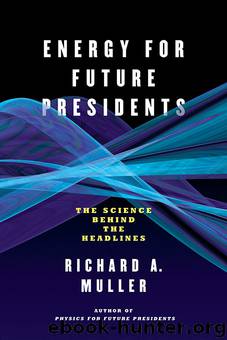Energy for Future Presidents by Richard A. Muller

Author:Richard A. Muller
Language: eng
Format: epub
Publisher: W. W. Norton & Company
Published: 2012-07-26T16:00:00+00:00
Cost
Nuclear power has a reputation of being the most expensive kind of traditional electric power production. This perception is based in large part on the simple observation of the high capital cost it takes to build and install 1 gigawatt of capacity: currently between $6 billion and $8 billion. That’s about 50% more than it costs to build a 1-gigawatt coal plant, and over 4 times more than the cost to build a conventional natural-gas plant. The high cost is a result of the complexity of nuclear power plants and the high quality control needed in their construction. With such a high price it seems absurd to go nuclear—so why are nuclear power plants still being built? Is there a conspiracy? Maybe there are subsidies; maybe the nuclear lobby donates lots of money to politicians; maybe . . .
The calculation changes, however, when you include fuel and operating costs. After the plant is built, the incremental cost of electricity from nuclear power is cheaper than from any other source except hydroelectric dams. According to the US Energy Information Administration, 80% of the cost of electricity from nuclear power comes from paying back the loans (with interest) for the construction cost, the capital investment. In contrast, for a natural-gas power plant only 18% of the cost is for capital investment; the rest is the cost of the fuel. For natural gas at US prices, the net cost is still lower than for nuclear, but in other places around the world, nuclear is competitive.
Nuclear wasn’t always this cheap. Over the past 30 years the plant capacity factor—the fraction of the time the plant is operating and delivering power—rose from 55% to nearly 90%.20 The improved capacity factor makes a big difference to an investor. If the plant operates only half of the time, then you’re earning money only half of the time. Today, with plants operating 90% of the time instead of 55%, yearly revenues are 1.6 times larger. This improvement is primarily due to better operating procedures, use of modern computers to monitor and control the plant, and a great deal of experience—regularly shared among reactor operators at meetings and workshops.
Back in the 1970s, nuclear power surged; in 1973 alone, US utilities ordered 41 new plants. Then, in 1979, the Three Mile Island accident occurred. Although the Kemeny Commission that studied the accident determined that nobody had been killed, it did report some health damage to the public—by psychological stress on an unnecessarily frightened public who thought the accident was much worse than it really was, perhaps because they had recently seen the movie The China Syndrome in theaters, a movie that assumed incorrectly that reactors could blow up like atomic bombs. Orders for new nuclear reactors came to a halt. Then, in 1986, a truly catastrophic reactor accident occurred at Chernobyl, causing 30 prompt deaths (mostly firefighters),21 an estimated 24,000 long-term cancers from the released radioactivity, and an evacuation of the surrounding region.
Nuclear power continued to provide about 20% of US electric power, but no new plants were ordered.
Download
This site does not store any files on its server. We only index and link to content provided by other sites. Please contact the content providers to delete copyright contents if any and email us, we'll remove relevant links or contents immediately.
The Secret History by Donna Tartt(16618)
The Social Justice Warrior Handbook by Lisa De Pasquale(11489)
Thirteen Reasons Why by Jay Asher(7786)
This Is How You Lose Her by Junot Diaz(5768)
Weapons of Math Destruction by Cathy O'Neil(5034)
Zero to One by Peter Thiel(4823)
The Myth of the Strong Leader by Archie Brown(4789)
Promise Me, Dad by Joe Biden(4444)
Stone's Rules by Roger Stone(4415)
Beartown by Fredrik Backman(4413)
How Democracies Die by Steven Levitsky & Daniel Ziblatt(4397)
The Fire Next Time by James Baldwin(4341)
100 Deadly Skills by Clint Emerson(4076)
A Higher Loyalty: Truth, Lies, and Leadership by James Comey(4031)
Rise and Kill First by Ronen Bergman(4012)
The David Icke Guide to the Global Conspiracy (and how to end it) by David Icke(3881)
The Farm by Tom Rob Smith(3871)
Secrecy World by Jake Bernstein(3782)
The Doomsday Machine by Daniel Ellsberg(3730)
